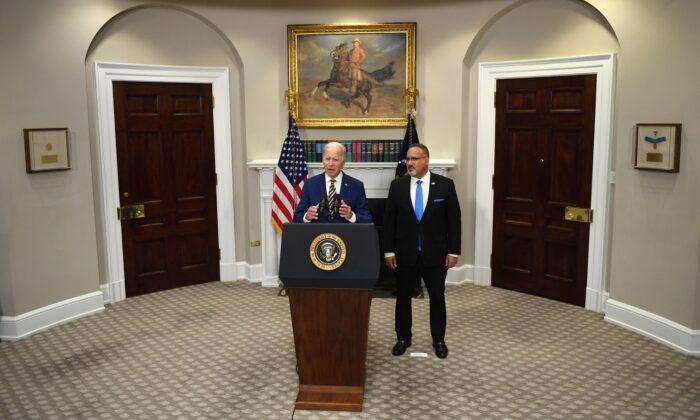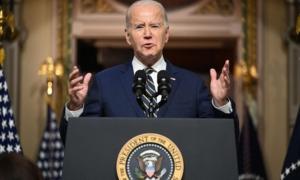It’s a pattern with which we’ve become very familiar. Two weeks of lockdown became two years. One hundred days of masking turned into a full year, and the Biden administration is still fighting to bring back the mandate on transportation. The temporary pain of price increases has turned into a permanent state of affairs in which the hopes of sound money have been completely dashed.
“Since the pandemic,” he said, “we’ve been living in a world where the economy is being driven by very different forces. What we don’t know is whether we will be going back to something that looks more like, or a little bit like, what we had before.”
The cancellation of student debts of less than $10,000 is a pittance compared to what’s been happening behind the scenes and is already planned for the future. Nearly all the Paycheck Protection Program loans of 2020 have already been forgiven, including those made to the wealthiest 1 percent. The student loan forgiveness scheme is the same.
“Approximately 43 million student loan borrowers in the United States owe a collective nearly $1.75 trillion in federal and private student loan debt as of August 2022,” Stockman wrote. “But when you look at the average amounts owed, the case is crystal clear: Student debt is overwhelmingly an investment in professional credentialization that should never have been an obligation of the taxpayers in the first place.
“And now between subsidized interest rates, the COVID moratoriums, and Joe Biden’s $10,000 cancellation, it amounts to a taxpayer subsidy of the most affluent class of American citizens.”
Also think about all the parents who worked so hard to keep their children out of debt, or those students who worked and studied so hard through school to shell out for overpriced tuition, books, and dorms. They look at what’s happening now and wonder what the point of all that was.
“Pouring roughly half trillion dollars of gasoline on the inflationary fire that is already burning is reckless. Doing it while going well beyond one campaign promise ($10K of student loan relief) and breaking another (all proposals paid for) is even worse. ... There are a number of other highly problematic impacts including encouraging higher tuition in the future, encouraging more borrowing, creating expectations of future debt forgiveness, and more.”
In the last year, the COVID-19 policy response not only obliterated scientific standards, but we have economics itself being blown up as well, as the government pursues policies that run counter to hundreds of years of theorizing and exhortation.
How is it that such a dramatic fiscal decision would take place by the president’s authority alone without any legislation or even debate from Congress? In the constitutional system that still more or less remains, Congress controls the purse. So how is this even possible?
“The HEROES Act, first enacted in the wake of the September 11 attacks, provides the Secretary broad authority to grant relief from student loan requirements during specific periods (a war, other military operation, or national emergency, such as the present COVID-19 pandemic) and for specific purposes (including to address the financial harms of such a war, other military operation, or emergency). ... In present circumstances, this authority could be used to effectuate a program of categorical debt cancellation directed at addressing the financial harms caused by the COVID-19 pandemic.”
Here again, we see how COVID-19 emergency powers have unleashed a regime of command and control that would have been unthinkable in past times. The framers specifically constructed the Constitution to prevent just this sort of centralization.
COVID-19 served as the convenient pretext to scrap the whole document and system. That’s why the emergency keeps being extended into the future. It’s all about giving a free hand to the administrative state to work closely with the biggest players in industry and finance to rig the system to work for themselves and at the expense of everyone else.
The “very different forces” that Powell referred to mean not markets and not free people but rather insiders and big shots manipulating the system to benefit themselves. Having seen what was possible during lockdowns, they aren’t about to give that power up unless they’re forced to by some dramatic political change in the future.
But even with that change, the United States has a terrible problem right now, namely an exploding national debt that would have been simply inconceivable a decade or two ago. Back in the 1980s, responsible lawmakers worried about this. Now, a wild fiscal nihilism has swept through Washington, and it appears that hardly anyone is particularly concerned about the future.
![(Data: Federal Reserve Economic Data [FRED], St. Louis Fed; Chart: Jeffrey A. Tucker)](/_next/image?url=https%3A%2F%2Fimg.theepochtimes.com%2Fassets%2Fuploads%2F2022%2F08%2F25%2F1-JAT-2022.08.25-1200x939.png&w=1200&q=75)
Who’s going to pay for this and how? There are only so many taxes a government can collect. That’s where inflation comes in. It’s a tried and true trick by governments from time immemorial to service debts with money that’s in a constant state of depreciation via money printing by the central bank. The pattern was set in motion in 2020 and now that policy has become the way Washington works. It’s a stealth taxation that doesn’t require forcing people to cough up.
Meanwhile, on Main Street, real household income is falling off a cliff, credit card debt is being maxed out, utility bills are soaring, 20 million people are behind on their electricity bills, and hopes for the future are being dashed by the day. Turning this problem around at this stage will require herculean efforts by a generation of leaders who thoroughly understand the problem and the solution.







